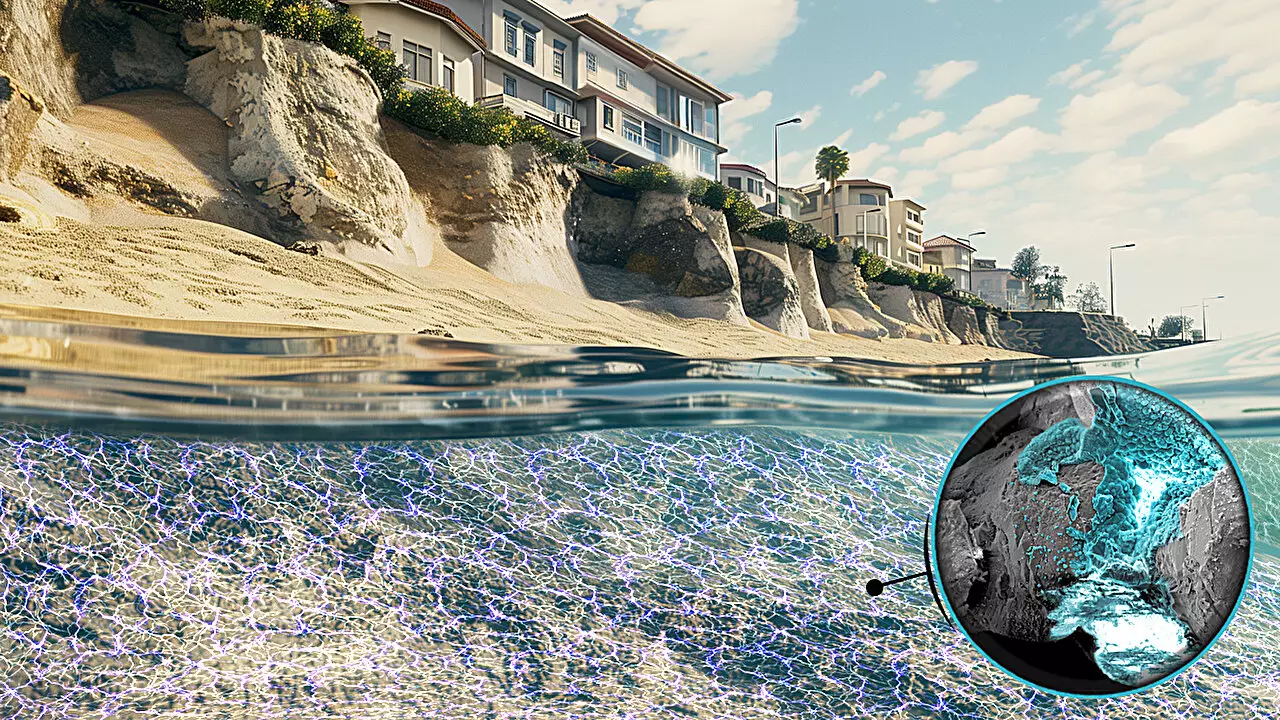Coastal regions around the world are grappling with an increasing threat from climate change, particularly in the form of rising sea levels and extreme weather events. As a consequence, the stability and integrity of coastlines have become critical issues, threatening the livelihood of millions. A recent study from Northwestern University is shedding light on a groundbreaking technique that could serve as a sustainable solution, utilizing mild electrical currents to strengthen coastal sands and mitigate erosion.
The research draws inspiration from natural processes observed in marine life, particularly organisms such as clams and mussels that utilize dissolved minerals from seawater to create their protective shells. Unlike these creatures, which rely on metabolic energy, the researchers applied a mild electrical current to induce a chemical reaction that would convert these dissolved minerals into a natural cement. The resulting process, termed “electrodeposition,” effectively binds marine sands together, transforming loose granules into a solid, rock-like mass.
Laboratory experiments demonstrated that applying a slight electrical voltage between 2 to 4 volts was sufficient to catalyze this reaction. This astonishing finding indicates that marine sediments, when treated electrically, solidify into a resilient structure much stronger than concrete—an answer to the perpetual issue of coastal erosion.
Historically, coastal protection strategies have revolved around physical barriers such as sea walls, or injecting traditional binders into the substrate. However, these solutions are not without their flaws. Sea walls can succumb to erosion over time, leading to costly decay and requiring constant maintenance. Moreover, conventional methods often demand significant financial investment and have a considerable environmental footprint, both of which limit their effectiveness and sustainability over the long term.
By pivoting towards a methodology inspired by nature and using minimally invasive electrical stimulation, the research team has opened up new avenues for managing and reinforcing coastal environments. According to Alessandro Rotta Loria, the lead researcher, the electrical approach offers a fundamentally different model that could reshape how communities address the challenges of coastal erosion effectively and economically.
One of the most striking aspects of the study is the cost-effectiveness of the electrical method. The researchers found the expenses associated with electrically cementing sand to be significantly lower—averaging between $3 to $6 per cubic meter—compared to the $70 required for other binding techniques. This high level of affordability positions the electrical method as a feasible alternative for local governments and communities facing dwindling budgets for coastal protection.
Additionally, the treated sand can potentially maintain its enhanced structural integrity for decades with minimal maintenance. This longevity represents a leap forward in ensuring the safety and stability of coastal infrastructures and habitats. Furthermore, the method is reversible, allowing communities to dissolve the cemented sand if they choose to revert back to its original state, offering flexibility not found in traditional solutions.
A common concern with any intervention in natural systems is its potential impact on marine life. Fortunately, the mild voltages employed in this technique have been verified as harmless to surrounding flora and fauna. Past studies utilizing similar electrical methods for coral reef restoration confirm that no adverse effects were evident; thus, reinforcing the notion that this approach is mindful of ecological balances.
Rotta Loria and his colleagues are keenly aware of the ecological ramifications of coastline management, and their commitment to preserving marine environments while providing effective solutions indicates a promising pathway for sustainable coastal defense efforts.
As research progresses, the team plans to conduct field tests, moving beyond the controlled laboratory setting to apply this technique in real-world coastal environments. By assessing its effectiveness on actual beaches, researchers hope to validate their findings and refine the methodology for practical use.
The potential applications for this electrical cementing technique are extensive, extending beyond mere shoreline reinforcement. Possibilities include stabilizing sand dunes, mending weakened marine foundations, and even repairing cracked concrete structures. The versatility of this method underscores its potential as a transformative force in coastal engineering.
With climate change presenting formidable challenges to coastal communities worldwide, the recent advancements in electrical cementing technology herald a new era in erosion prevention. This innovative method not only strengthens sandy substrates but also does so in a cost-effective, environmentally sensitive manner. As researchers move forward with real-world applications, the hope is to steer coastal management away from traditional and costly approaches towards more sustainable and efficient solutions. The future of coastal protection may very well lie in the gentle touch of electricity, providing a glimmer of hope for vulnerable shorelines everywhere.


Leave a Reply